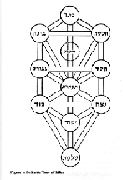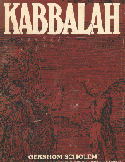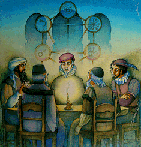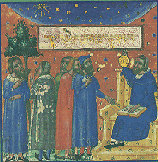Kabbalah Now





 Kabbalah, or received knowledge, is a method of perceiving the hidden
aspects of the world according to the Jewish tradition. It is supposed to
have been given to Moses on Mount Sinai, and to have been passed on, orally,
until the time of the first Temple, the time of David. The first written
accounts come from the first or second century, CE. So why study it now, in this
age of technology? Are we not too advanced for such ancient ways?
Kabbalah, or received knowledge, is a method of perceiving the hidden
aspects of the world according to the Jewish tradition. It is supposed to
have been given to Moses on Mount Sinai, and to have been passed on, orally,
until the time of the first Temple, the time of David. The first written
accounts come from the first or second century, CE. So why study it now, in this
age of technology? Are we not too advanced for such ancient ways?
Actually, it is precisely such a method of organizing our perceptions of the
world (of perceiving the world), one which is both analytic and holistic that
is needed at this time. Our over-reliance on rationality has gotten us in the
position of not seeing the forest for the trees, of getting trapped in local
minima of perceptions of the world and in missing some of the global features.
I hope that an approach like Kabbalah can restore in us the ability to also
perceive global and local aspects of the world.
I have had several teachers who have taught me about Kabbalah, whether they
knew it or not :) :Mira Zussman, David Friedman, Shlomo Carlebach, Zalman
Schachter-Shalomi, Henry Falkenberg. My other
teachers have also enriched my life.
Websites on Kabbalah .
This method, Kabbalah, should not be applied carelessly. There are
dangers that come with it. In the olde days, the Talmud stipulated that
only men over 40 years of age, married, and steeped in the wisdom of the
Talmud - commentaries on the Bible - were to study Kabbalah. The implication
was that one should be mature, stable and anchored in the Jewish tradition.
These limitations were not observed all the time, yet there is a sens in which the study of Kabbalah should still be approached with care.
I want to start with a quote from
Aryeh Kaplan's book on Meditation and Kabbalah
regarding the warning. It comes from the Talmud itself:
Four entered the Orchard


(Pardes). They were Ben Azzai, Ben Zoma, the Other, and Rabbi Akiba. Rabbi Akiba warned, "When you enter near the stones of pure marble, do not say 'water water,' since it is written, 'He who speaks falsehood will not be established before My eyes'" (Psalms 101:7).
Ben Azzai gazed and died. Regarding it is written, 'Precious in God's eyes is the death of His saints' (Psalms 116:15).
Ben Zoma gazed and was stricken. Regarding him it is written, 'You have found honey, eat moderately least you bloat yourself and vomit it' (Proverbs 25:16).
The Other (Elisha ben Abuya) gazed and cut his plantings (became a heretic).
Rabbi Akiba entered in peace and left in peace...
The angels also wished to cast down Rabbi Akiba but the Blessed Holy One said, "Leave this elder alone, for he is worthy of making use of My glory."
Let me give my own brief




 Midrash (commentary) on it:
Midrash (commentary) on it:
This is but one interpretation of the story. As I discuss in my
Quantum PsychoAlchemy talk there are
several levels of meaning in Kabbalah. I have only given one of
them. It is also probably meaningful that there are four examples
in the above story, like the four letters in the Divine Name,



 .
This is usually translated as Yaweh, but according to Jewish tradition, it
is never pronounced.
.
This is usually translated as Yaweh, but according to Jewish tradition, it
is never pronounced.
I have also learned about Kabbalah from my studies in ceremonial magick. Here are a couple of wonderful books between pure kabbalistic exposition and Golden Dawn work, by Israel Regardie.
The first work, The Garden of Pomegranates






 _
_



 Pardes Rimmonim, written by R. Moses Cordovero in the 16th century in Italy.
it contains the alchemical and allegorical meaning of the Hebrew
Pardes Rimmonim, written by R. Moses Cordovero in the 16th century in Italy.
it contains the alchemical and allegorical meaning of the Hebrew

 aleph-beit as well as a discussion of the paths of the Tree of Life and a
discussion of
aleph-beit as well as a discussion of the paths of the Tree of Life and a
discussion of




 _
_


 Adam Kadmon, the Primordial Human.
Adam Kadmon, the Primordial Human.
Another classic book if Kabbalah is




 _
_


 Sefer Yetzirah, The Book of Formation. I like in particular
Aryeh Kaplan's wonderful translation, since he
gives both the Hebrew and the English text.
Sefer Yetzirah, The Book of Formation. I like in particular
Aryeh Kaplan's wonderful translation, since he
gives both the Hebrew and the English text.

Sefer Yetzirah deals with the mystical account of the building blocks of creation,
the Hebrew aleph-bet, the ten





 Sephirot, Emanations, and the twenty-two paths connecting these Emanations.
It discusses the various combinations of two letters and their possible meanings.
It also touches a bit on a system of meditation later developed more fully by
Abulafia.
Sephirot, Emanations, and the twenty-two paths connecting these Emanations.
It discusses the various combinations of two letters and their possible meanings.
It also touches a bit on a system of meditation later developed more fully by
Abulafia.
The best know Kabbalistic book is



 _
_


 Sefer haZohar, the Book of Splendor, which dates from the 12th century,
and was transmitted through R. Moses de Leon of
Sefer haZohar, the Book of Splendor, which dates from the 12th century,
and was transmitted through R. Moses de Leon of



 Safard (Spain). Here is a quote form R. Kaplan's book on
Jewish meditation, which gives a sensual interpretation of the
Zohar:
Safard (Spain). Here is a quote form R. Kaplan's book on
Jewish meditation, which gives a sensual interpretation of the
Zohar:
The Zohar states that a kiss is the merging of one breath with another. Love begins with the physical attraction. Then, as lovers begin communication, they begin to speak. A they get closer, they stop speaking and are merely aware of each other's breath. Finally, they come closer still, and their communication becomes a kiss, at which point they are actually in physical contact. At this moment, in the kiss, they are aware of each other''s life force. Kissing is thus a natural consequence of increased intimacy in speech. The two mouths come closer and progress from speech, to breath, to the kiss. Thus there are four levels in the intimacy of love: physical attraction. speech, breath, and the kiss. These same levels exist in the relationship of a person with the Divine.
This level corresponds to a still higher level of the soul, even above


neshamah. This fourth level of the soul is known as



chayyah, which literally means 'life force.' If the level of neshamah involves an awareness of the breath of the Divine, then the level of chayyah is the awareness of the divine life force itself.
Aryeh Kaplan, Jewish Meditation
The book itself deals with




 Midrash - analysis, discussion - relating to various portions of the
Midrash - analysis, discussion - relating to various portions of the



 Torah, as well as some mystical portions which make sense read only in the
original Hebrew.
Torah, as well as some mystical portions which make sense read only in the
original Hebrew.




 _
_



 Ma'asseh Yetzirah, and refers to viewing the hidden mysteries of the world from above.
Ma'asseh Yetzirah, and refers to viewing the hidden mysteries of the world from above.
Gershom Scholem gives a wonderful account of the whole of Kabbalah in his book.

This book is an exhaustive account of the whole kabbalistic endeavour
over the past two thousand or twenty-five hundred years. Thanks to this book, I
have learnt of another approach, the Work of the Chariot,




 _
_



 Ma'asseh Merkavah, referring to the approach first constructed by the
Jewish mystics based on the work of Ezekiel. His visions of the Throne
are among first such excursions in these non-physical worlds.
Ma'asseh Merkavah, referring to the approach first constructed by the
Jewish mystics based on the work of Ezekiel. His visions of the Throne
are among first such excursions in these non-physical worlds.
I have found Z'ev ben-Shimon ha-Levi's books, like The Anointed,


The Way of the Kabbalah describes very well the Ladder with its
intertwined Worlds of



 Assiyah or Material, Yetzirah or Formation,
Assiyah or Material, Yetzirah or Formation,




 Beriah or Creative, and
Beriah or Creative, and




 Atzilut or Archetypal. He also gives a good account of
how to go down and up the Ladder, how to descend and ascend -see
my performance
The Tree, the Ladder, the Chariot and the Self.
He also discusses how to form
a study group,
I presume like the one described in his book,
The Anointed.
Atzilut or Archetypal. He also gives a good account of
how to go down and up the Ladder, how to descend and ascend -see
my performance
The Tree, the Ladder, the Chariot and the Self.
He also discusses how to form
a study group,
I presume like the one described in his book,
The Anointed.
I should point out that there are literally thousands of books which purport
to discuss Kabbalah, many of which can lead the unwary reader astray.
Kabbalah is a difficult maze, where one needs analytical understanding,



 Binah understanding, to make any sense of the information given.
Binah understanding, to make any sense of the information given.
Kabbalah has even appeared in popular culture. There is of course, The Illuminatus! Trilogy, a mish-mash of counter-culture, magick, and a good "message" to think for oneself. Then, there is Umberto Eco's wonderful novel about this maze which is Kabbalah. Eco names the sections of his book after the ten Sephirot mentioned above -as do Shae and Wilson in their book! - and the structure of the respective sections deal with topics which have the feel of the respective Sephira.
I have tried to stay pretty close to traditional sources. Perhaps I have
missed some opportunities this way. Who knows? I would accept any suggestions at
the mail below. My activities in this direction have consisted in study as well
as presentations to other people, in the form of
talks, and
performances.
My kabbalistic study has also influenced my
philosophical ideas on modernity, my thoughts
on politix, my interest in
music, my
physics research, and my
conscious sense of myself. I started
along this path due to my interest in
PsychoAlchemy.
It also links me to other interests on the
net.
At present I am also involved in a
Kabbalah study group,
where we talk about various aspects of the Work.

admin@mishkan.com